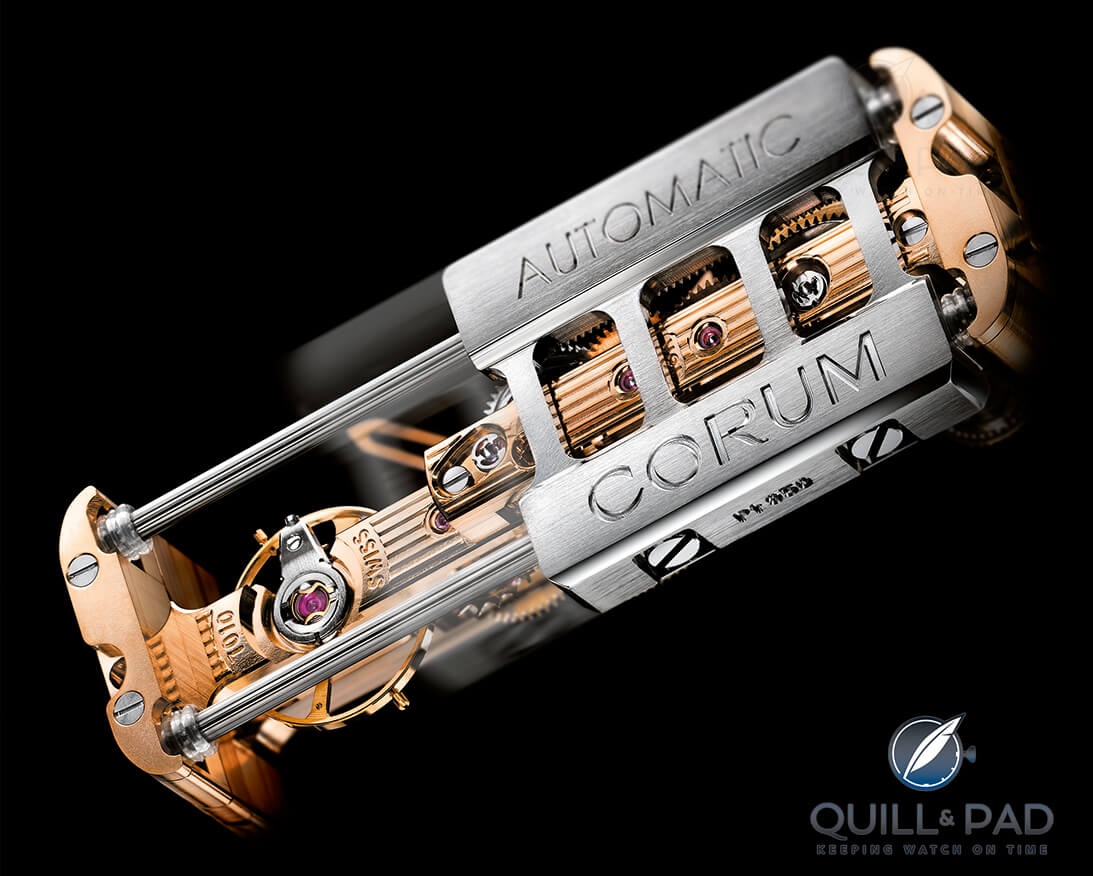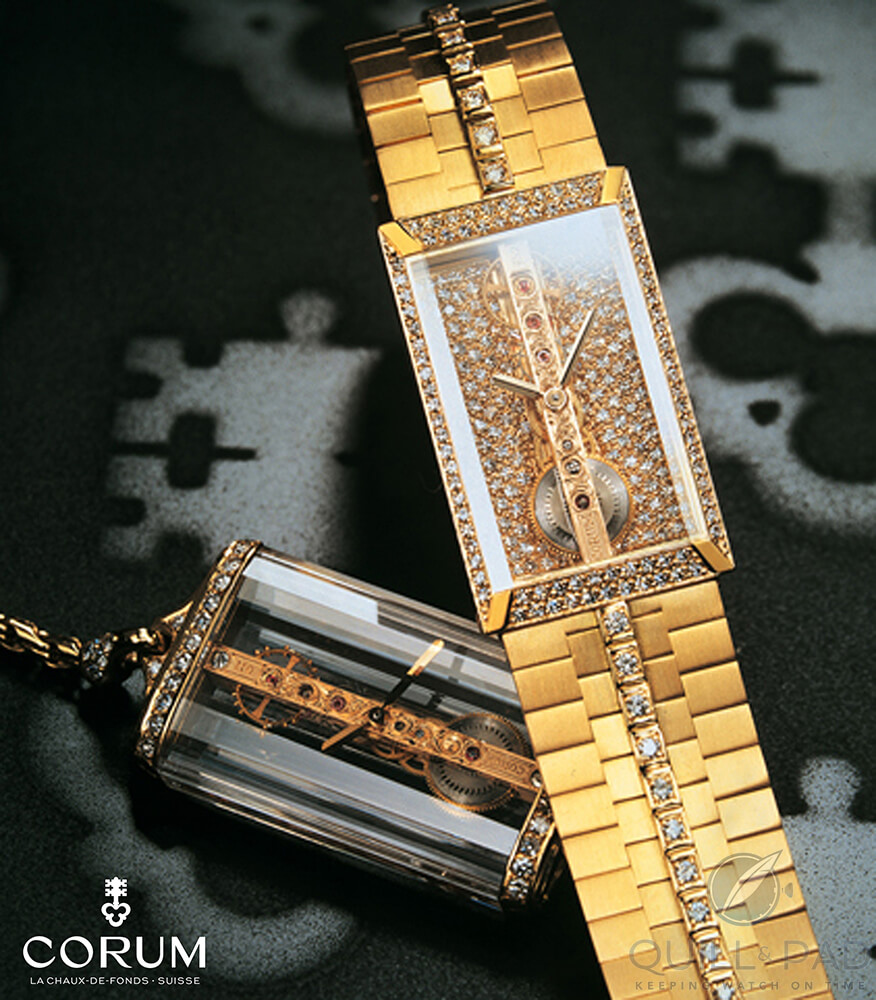History is perhaps better told by those who have lived it, and claims are better made by those who have seen or experienced them. Since I am still a spring chicken and have not personally experienced the history behind today’s piece, I will refrain from quoting others about the origins of one of my favorite creations: the Corum Golden Bridge.
Instead, I will begin with a touch of my own history why I find a kinship with the piece, why I think it was created, and why I think it that the watch gained such popularity.
Before I realized that I loved watches I was sure that I loved mechanical things, and stood in awe of the many mechanisms and contraptions that I saw over my young life. These included robotics, engines, and industrial equipment, all the way down to neat little hinges or clever tools that I saw my father use in the garage.
Basically, I was curious about how things worked. I’m aware I have said much of this before, but it deserves repeating since it is still, to this day, a driving force for almost every passion I have.
Once I became aware of watches and the amazing marvels that they held within, I had the feeling that some things looked familiar. I could never be sure, and nobody else I knew was even partially knowledgeable about the subject or my exposure to mechanics as a child, but I felt that I had seen some of the watches I began learning about before.
And one of those just happened to be one of my favorites as well, the Corum Golden Bridge.
Perfect horological exhibitionism
To me, the Corum Golden Bridge stood out as an example of perfect horological exhibitionism. There have been many skeleton watches over the years, and more recently there has been a renaissance of exposed movements and featured mechanics. I personally feel that this helps remind people that mechanical watches are pretty darn incredible and, to the uninitiated at least, seemingly impossible creations.
Of all the watches that extol the virtues of the mechanical movement, no other piece does it as simply, cleanly, or straightforward in manner as the Golden Bridge.
In a skeletonized watch, the wearer can attempt to follow the path of the power from the mainspring to the hairspring, and if they are lucky, they might be able to deduce how it works.
But with the linear arrangement invented by Vincent Calabrese, it is almost impossible to not understand how it works. If I think back to my earliest adventures with watches, this movement helped me to first understand the mechanics, long before I became a full-blown WIS (Watch Idiot Savant, in other words, watch geek).
Vincent Calabrese’s stroke of genius
Here I would also like to pose my own theory that the Golden Bridge is at least partially responsible for a continued passion for mechanical watches after the early days of the quartz crisis.
Invented in 1977 by Calabrese and first publicly available from Corum in 1980, the Golden Bridge couldn’t have come at a better time. It showed both watch aficionado and technophile alike that there is beauty in the mechanics, and that they are worth a closer look instead of being abandoned for the latest electronic technologies.
Now, after more than 30 years of Golden Bridge production, it has received some very nice upgrades. The Golden Bridge Automatic Titanium is the latest and (arguably) greatest example of the model. I will admit that the Golden Bridge Dragon is astounding as well, but I still prefer the mechanics in the Automatic Titanium model.
My favorite feature
Let’s start with a feature I didn’t notice until it was pointed out, which is now one of my favorite elements even though it happens to be a static component: the case back.
Wait, wait, let me explain. Normally I don’t go gaga over the case back unless it is . . . well, I’ve never actually gone gaga over a case back. But this one utilizes materials and optics to its advantage, and I can truly appreciate that.
The case back is mainly, of course, a transparent sapphire crystal. Added to the inside of the crystal are very small red gold, metalized stripes running parallel to the bridge movement.
These lines create texture and when viewing the movement from the rear and make for a nice pattern overlaying the linear weight and movement. Also, since the point of the Golden Bridge timepiece is to make the movement appear to float in the case, it does not impede your view by covering anything up.
Put the watch on the wrist and the story changes. Based on the proximity of the lines to each other, and the fact that light is now only coming from the front of the movement, the rear case back appears almost opaque, and the hairy wrist underneath disappears (well my hairy wrist did anyway).
As far as I can tell, this is due to the light not being able to bounce cleanly through the sapphire, onto the wrist (and due to refraction on the rear side of the sapphire crystal) and back out again before being mainly scattered or absorbed by the metalized lines.
Techniques like this have been in use for electronics, privacy, and optical control recently, though I still have not had much hands-on experience with something so simple and complicated at the same time.
Linear automatic winding
Now we move on to the bag-o-fun that is the linear oscillating weight powering the automatic winding. It is just cool. Basically, the design and construction of the Golden Bridge movement has been begging for this feature ever since its inception. And almost no other movement is as well-suited for it like Caliber CO313.
The feature comprises a four-gram platinum mass attached to a carriage that slides along Teflon-coated steel rails. The carriage incorporates beryllium copper sleeves for further reduced friction, while the rails are topped with rubber o-rings that provide a cushion for the weight at each end of its one-centimeter journey.
But most importantly, included in the carriage design is a gear rack on one side to translate the linear motion into rotational motion and wind the watch. To prevent over-winding and reduce complexity, winding only occurs in one direction and the rack “slips” in the other direction. Similar to many rotor designs, really, just made to match the straight lines of the Golden Bridge.
Oh yes, the Golden Bridge, the reason we are all here. What can I really say about a movement that is 37 years old and still holds the same appeal as the day it was debuted? Its simplicity is its main virtue; the linear layout of the gear train seems like it would be the perfect training tool, and I have heard it actually is used as such since it makes the most sense visually.
I may never personally own a Golden Bridge, and this new one in titanium is definitely the most wearable one for a guy who is a little rough on his watches, but I can say this: the Golden Bridge is, in my humble opinion, one of the most seductive horological movements in a watch today.
Many movements feature incredibly complicated functions and astounding engineering. But sometimes the thing that you really want is a strictly clean and straightforward example of a top-notch movement.
I compare the Golden Bridge to a Porsche: an iconic design that was pretty much perfect from the beginning, clean and simple without being overly flamboyant like a Lamborghini or Bugatti. The latter are two amazing cars, and I would take either of them any day. But on the days when I just want to drive and enjoy the simple pleasure of driving, I would hop in the Porsche, and on my wrist would be the Golden Bridge.
Let’s just hope the Porsche doesn’t break down, though . . . did somebody say breakdown?!
• Wowza Factor * 9.65 Floating, but very differently from last week; can’t get much better.
• Late Night Lust Appeal * 89.98 gn » 882.402m/s2 Let’s face it, you won’t be going anywhere when you catch a glimpse of these. At least nowhere but down the rabbit hole of lust.
• M.G.R. * 66.4 The Golden Bridge movement is what I claimed it to be: perfect horological exhibitionism.
• Added-Functionitis * N/A For as much as I love complications, I seem to love a lot of pieces that are time-only! Oh well, at least you can bypass the Gotta-HAVE-That cream.
• Ouch Outline * 11.21 – Being Attacked By A Pack Of Wild Squirrels I have a feeling that this would actually be absolutely terrifying, being that they are small, super fast, and yet unnervingly cute. I will still go out on a limb to say I would take it to get the Golden Bridge Automatic Titanium on my wrist.
• Mermaid Moment * Look At That Movement! WIS and non-WIS alike share an affinity for this timepiece, and especially this movement. Just getting a glimpse of it makes the feeling of home wash over you and thoughts of what wedding favors you should choose run through your mind.
• Awesome Total * 507 Combine the caliber number with the number of components and you have a total to tell your mother about.
For more information, please visit www.corum.ch.
Quick Facts Golden Bridge Automatic Titanium
Case: 37.2 x 51.8 x 13.7 mm, grade 5 titanium with black DLC treatment
Movement: automatic Caliber CO313, baguette-shaped
Functions: hours, minutes
Price: 41,000 Swiss francs






























































Leave a Reply
Want to join the discussion?Feel free to contribute!